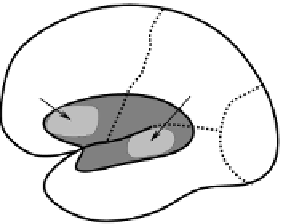Information Technology Reference
In-Depth Information
in speech production (but can also have comprehension
deficits as well). Specifically, they are unable to pro-
duce fluent speech, and often omit function words and
other aspects of grammatical structure. This pattern of
deficits makes sense if you think of Broca's area as a
supplementary and higher-level area for controlling (se-
quencing, organizing into grammatical forms) the mo-
tor outputs of the speech production musculature.
Wernicke's area, located right at the junction between
the superior temporal lobe and the parietal and occipi-
tal corticies (Brodmann's area 22, see figure 10.1), is
apparently involved in accessing semantic information
via language. Patients with damage to Wernicke's area,
who are said to have Wernicke's aphasia, exhibit im-
pairments in speech comprehension, and also produce
semantically incomprehensible speech, but they do so
fluently (though they do also make grammatical errors).
This pattern also makes sense, given that Wernicke's
area is probably important for associating language pro-
cessing representations in the temporal lobe with other
semantic information encoded in the occipital lobe (e.g.,
visual semantics) and the parietal lobe (e.g., spatial and
functional semantics).
Thus, Broca's and Wernicke's can be thought of as
complementary deficits, in the “surface” properties of
speech production and in the “deep” semantic proper-
ties of language comprehension and production, respec-
tively. The first model we examine expresses a simi-
lar set of complementary deficits when damaged in dif-
ferent places, but in the domain of reading instead of
speech (also observed behaviorally). Thus, the model
deals with
alexia
or
dyslexia
(these terms are often used
interchangeably to refer to deficits in reading ability).
Another very simplified way of thinking about the
distinction between Broca's and Wernicke's aphasias is
that Broca's involves a deficit in
syntax
and Wernicke's
involves a deficit in
semantics
. We will see in sec-
tion 10.7 that the frontal cortex location for Broca's area
is consistent with the need for actively maintained con-
text information to perform syntactic processing.
Although these distinctions between Broca's and
Wernicke's aphasia have some degree of validity, it
is important to emphasize that they fall short of ex-
plaining all of the neuropsychological data. For exam-
ple, the idea that Broca's area is responsible for syntax
Wernicke's
Broca's
Figure 10.1:
General areas of the cortex that appear to be
specialized for language (dark shading), containing Broca's
and Wernicke's areas as indicated.
cal areas and language functions, one overriding finding
has been that these relationships can be rather variable
across individuals.
We actually find this variability reassuring, because
it suggests that the kinds of general-purpose learn-
ing mechanisms used in our models play an important
role in shaping the biological substrates of language.
Clearly, learning plays a large role in language acquisi-
tion — we spend years gradually acquiring the structure
of our native tongue. Furthermore, we can be relatively
confident that the biological substrates specialized for
the written aspects of language are not genetically pre-
specified, because writing was developed well after evo-
lutionary selection could have developed a genetic basis
specifically for it. Nevertheless, as discussed in chap-
ter 4, there can be many complex interactions between
genetic predispositions or biases and the learning pro-
cess, and it seems reasonable that there may be some
genetic specializations that facilitate language learning.
With the important caveats of individual variation in
mind, we describe some very general aspects of the cor-
tical specializations for language. Most students of psy-
chology are probably familiar with the two brain areas
most commonly described as important for language:
Broca's
and
Wernicke's
. Broca's area is located in the
posterior prefrontal cortex (Brodmann's areas 44 and
45, figure 10.1) on the left side of the brain, and is ap-
parently responsible for the production of speech out-
put, including higher order grammatical and syntactic
aspects. Patients with damage to Broca's area, who are
said to have Broca's
aphasia
, primarily have deficits

Search WWH ::

Custom Search